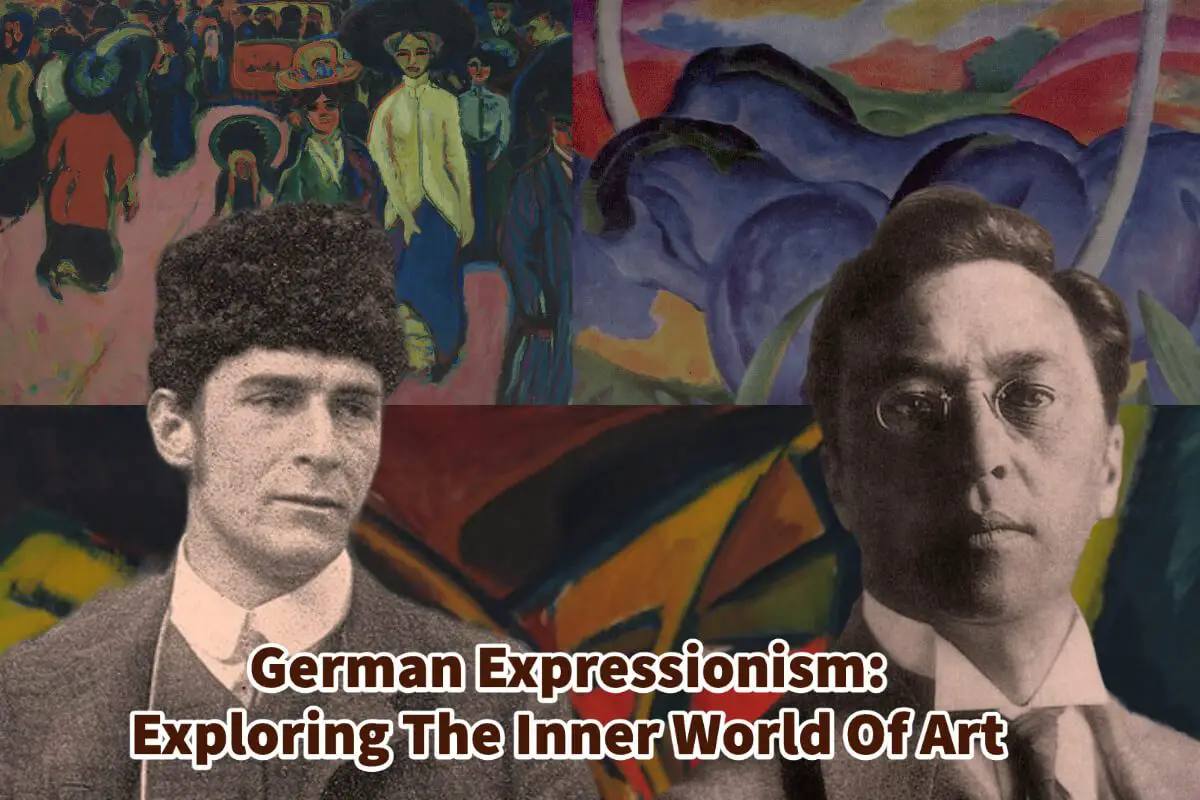German Expressionism emerged as a significant art movement in the early twentieth century, transcending traditional boundaries and pushing the limits of artistic expression. This revolutionary movement greatly emphasized the artist’s inner feelings, ideas, and experiences, valuing them over a mere replication of reality.
The German Expressionism Art Movement was characterized by simplified shapes, vibrant colors, and bold gestural marks or brushstrokes; German Expressionism captured the raw emotions and fierce spirit of the era during this time in Germany. Two main groups, Die Brücke (the bridge) and Der Blaue Reiter (The Blue Rider) played vital roles in shaping the German Expressionism movement.
Table of Contents
- German Expressionism’s Key Features
- Similarities And Differences Between Die Brucke And Der Blaue Reiter
- Frequently Asked Questions
- Related Questions
German Expressionism’s Key Features
At its core, German Expressionism sought to express the innermost thoughts and emotions of the artist. Rather than faithfully representing reality, artists aimed to convey their subjective experiences through distorted perspectives, exaggerated forms, and vivid colors.
This departure from conventional artistic norms gave birth to a dynamic and evocative visual language and the birth of German Expressionism.
Simplified shapes became a defining characteristic of German Expressionism. Artists employed bold, sharp contours and geometric simplification to amplify the emotional impact of their works—this reduction of forms allowed for heightened expression and a departure from the constraints of physical reality.
Bright colors played a pivotal role in capturing the intensity of emotions. Expressionist artists utilized vivid and non-naturalistic color palettes to evoke specific moods and psychological states. These colors were often applied non-representational, further distancing the artwork from objective reality.
Gestural marks and brushstrokes served as powerful vehicles for emotional expression. Artists embraced spontaneous, energetic brushwork, employing swift and bold strokes to convey a sense of urgency and intensity. This gestural approach created a dynamic visual rhythm that resonated with the inner turmoil and unrest of the era.
German Expressionism had two main groups under German Expressionism. One group was Die Brücke, the Bridge, and Der Blaue Reiter, or The Blue Rider.
Die Brücke (The Bridge)
Die Brücke was formed in Dresden, Germany, in 1905 by Ernst Ludwig Kirchner, Fritz Bleyl, Erich Heckel, and Karl Schmidt-Rottluff. The group aimed to forge a new artistic path that rejected traditional academic styles and instead sought to bridge the gap between the past and the future.
Die Brücke artists believed in the transformative power of art and saw it as a means to transcend societal constraints and reconnect with primal emotions.
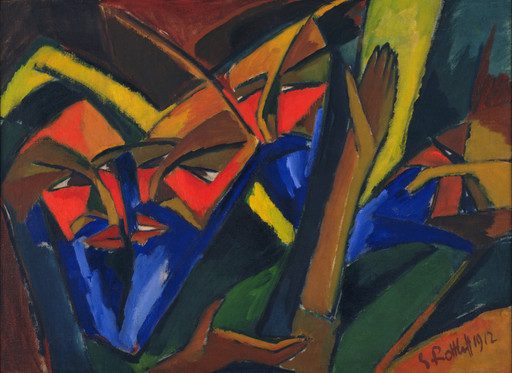
The members of Die Brücke focused on urban scenes, exploring the human condition in a rapidly industrializing world. They depicted the harsh realities of modern life, exposing the alienation and anxieties that came with it.
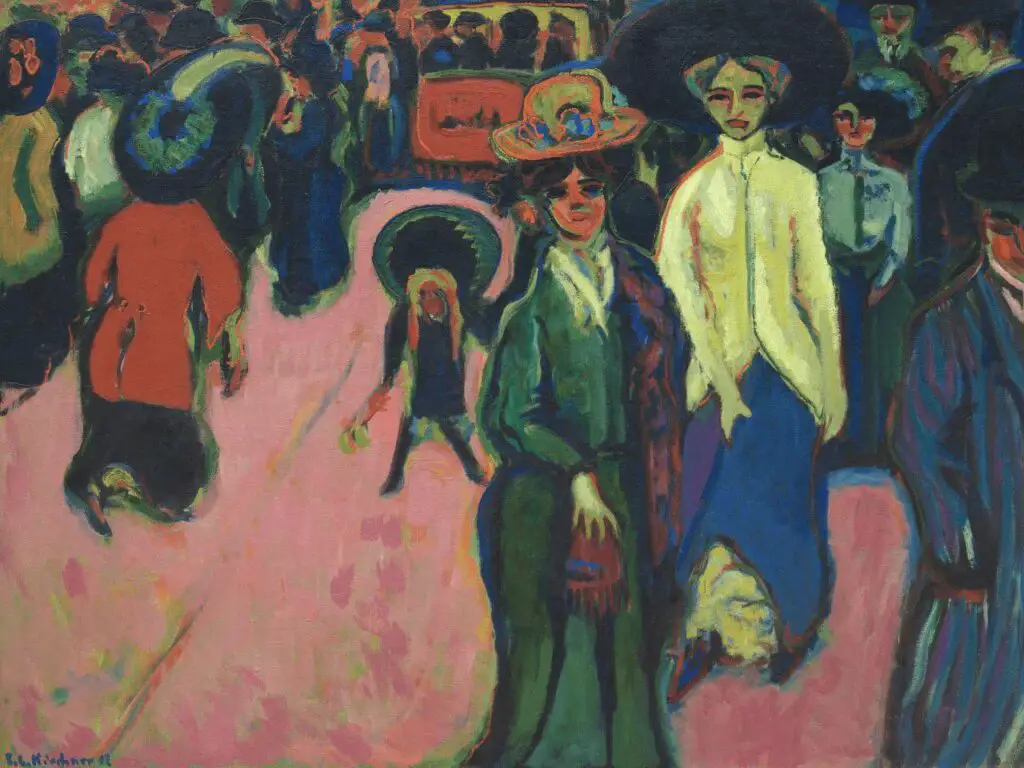
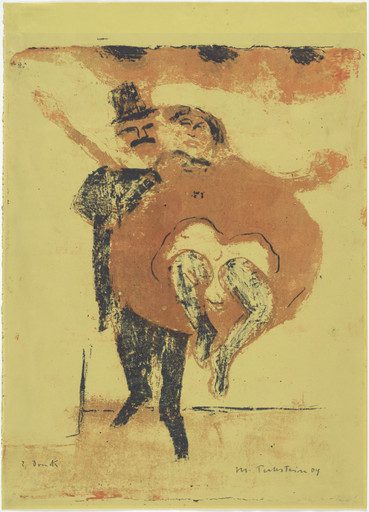
Their artworks often featured street scenes, cafes, and domestic interiors, characterized by distorted perspectives, exaggerated forms, and late intense colors.
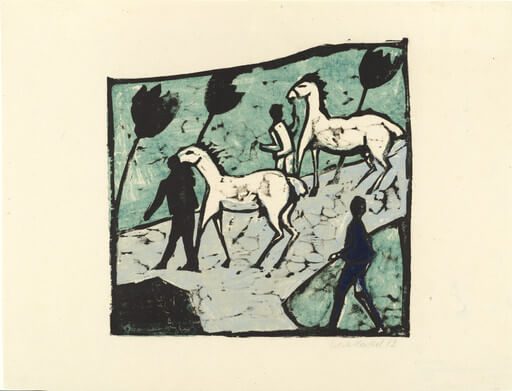
Die Brücke artists also embraced printmaking techniques, particularly woodcuts, to disseminate their ideas to a broader audience. This medium allowed for greater experimentation with bold lines, stark contrasts, and simplified forms, enhancing the expressive power of their artwork.
Der Blaue Reiter (The Blue Rider)
Der Blaue Reiter was founded in Munich in 1911 by Wassily Kandinsky and Franz Marc. The group sought to explore art’s spiritual and symbolic aspects, going beyond the tangible world to create a deeper, more profound connection with the viewer.
Der Blaue Reiter artists believed in the universal language of art and its ability to evoke spiritual experiences.
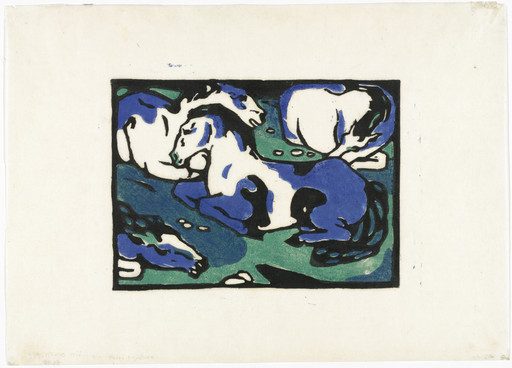
Unlike Die Brücke, Der Blaue Reiter artists moved away from urban scenes and delved into more abstract and mystical realms. They explored themes related to nature, spirituality, and the metaphysical.
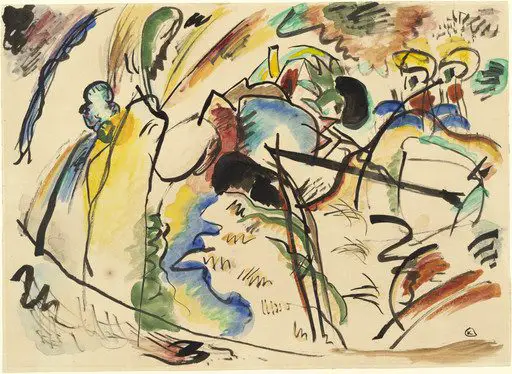
Their artworks often featured landscapes, animals, and fantastical elements, all imbued with a sense of the metaphysical.
Wassily Kandinsky And Der Blaue Reiter
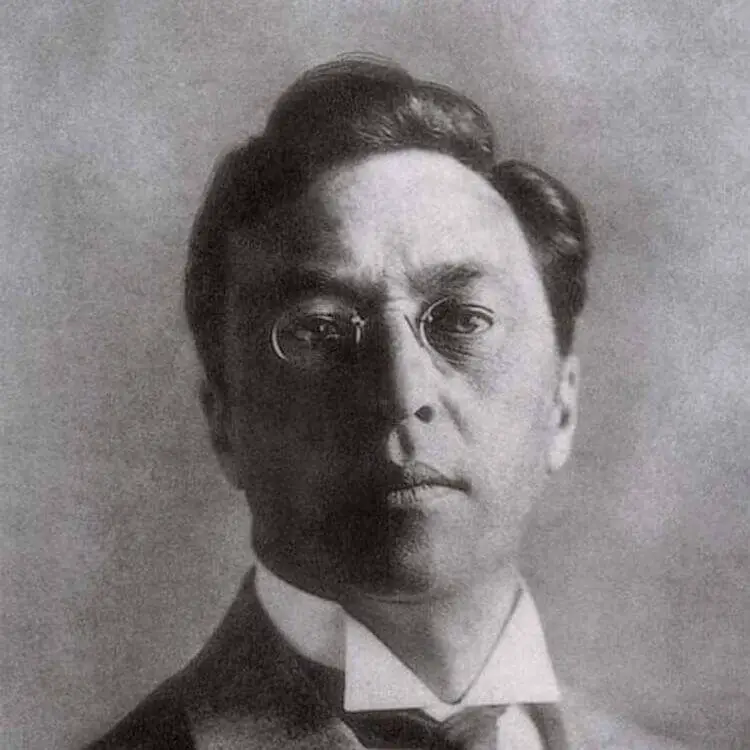
Wassily Kandinsky, a key figure in Der Blaue Reiter, believed in the power of color and form to evoke spiritual sensations. He developed a theory of abstract art, emphasizing the autonomy of colors and their ability to resonate with the viewer’s emotions.
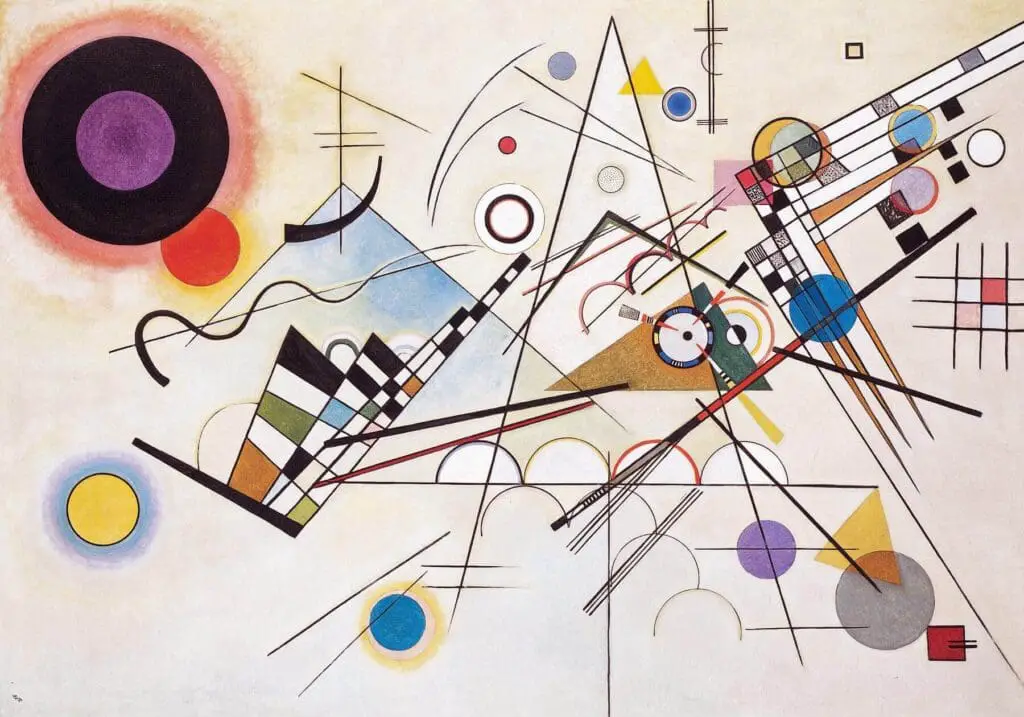
Kandinsky’s works were characterized by non-representational compositions, fluid lines, and vibrant colors that aimed to create a direct emotional impact on the viewer.
Franz Marc And Der Blaue Reiter
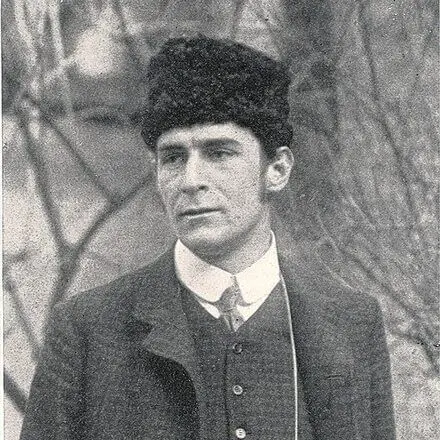
Franz Marc, another prominent member of Der Blaue Reiter, was deeply connected to nature and saw it as a source of spiritual renewal. He often depicted animals, using vivid and symbolic colors to convey their inner essence.
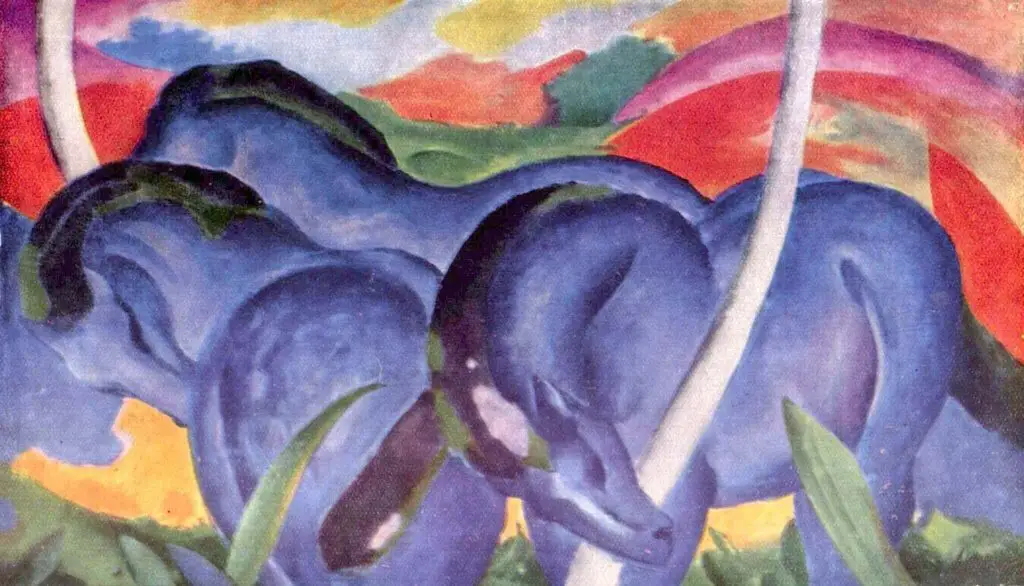
Marc believed that through art, humans could regain their lost connection with the natural world and find solace in its harmony.
Similarities And Differences Between Die Brucke And Der Blaue Reiter
Although Die Brücke and Der Blaue Reiter shared a common goal of breaking away from academic traditions and embracing the inner world of artistic expression, there were notable differences in their approaches and subject matter.
Both groups sought to challenge art’s established norms and create deeply personal and emotionally charged works. They rejected the notion of art as a mere imitation of reality and instead focused on capturing the artists’ subjective experiences and emotional states.
Die Brücke artists were more grounded in the urban environment and depicted the struggles and alienation of modern life. Their works often showcased the harsh realities of urbanization, exploring themes of social inequality, isolation, and the impact of industrialization on individuals.
They also employed distorted perspectives, intense colors, and bold brushwork to convey their subjects’ psychological tension and unease.
On the other hand, Der Blaue Reiter’s artists delved into the spiritual and metaphysical realms, exploring the connection between art, nature, and the metaphysical. Abstract forms, symbolic colors, and a sense of mysticism characterized their works.
They aimed to create a more profound spiritual experience through their art, inviting viewers to contemplate our existence’s universal and transcendental aspects.
Despite their differences, both groups played crucial roles in shaping the development of German Expressionism. They shared a rejection of academic traditions, a desire to explore the inner world of emotions, and a belief in the transformative power of art.
They both embraced the use of simplified shapes, vibrant colors, and gestural marks to convey the intensity of their subject matter.
German Expressionism was a groundbreaking art movement that emerged in the early twentieth century, prioritizing the artist’s inner feelings and ideas over replicating reality. Die Brücke and Der Blaue Reiter were two significant groups within this movement, each making unique contributions to the artistic landscape.
Both groups challenged traditional artistic norms and paved the way for further exploration and experimentation in artistic expression. With its emphasis on subjective experience, simplified shapes, vibrant colors, and gestural marks, German Expressionism left an indelible mark on the art world, inspiring future generations.
Anita Louise Art is dedicated to art education, great artists, and inspiring others to find and create their art. We love art that uplifts and aspires. #ArtToMakeYouSmile! #ArtToMakeYouHappy!
If you want to see any of my art, you can find out more by clicking here. If you are interested in what inspires me and my paintings, you can discover more by clicking here.
We have a free newsletter and would love you to be part of our community; you can subscribe to the newsletter by clicking here. If you have any questions, I would be happy to talk to you. You can reach me, Anita, by clicking here.
Subscribe to our Anita Louise Art YouTube Channel filled with great videos and information by clicking here.
Join us for our podcast “5 Minutes With Art.” Spend just 5 minutes a week with us to discover and learn about great art and artists. You can find out more about our podcast by clicking here.
Frequently Asked Questions
What is German Expressionism, and what distinguishes it from other art movements?
German Expressionism is an art movement that emerged in the early 20th century, characterized by a focus on the artist’s inner emotions and experiences rather than a realistic depiction of the external world. It is marked by simplified shapes, vibrant colors, and bold brushstrokes. This movement stands out for its departure from traditional artistic norms, emphasizing subjective expression.
Who were the key figures associated with German Expressionism, and what role did groups like Die Brücke and Der Blaue Reiter play?
Die Brücke and Der Blaue Reiter were pivotal groups in German Expressionism. Die Brücke, founded in Dresden in 1905, included artists like Ernst Ludwig Kirchner and Emil Nolde. Der Blaue Reiter, formed in Munich in 1911, counted Wassily Kandinsky and Franz Marc among its members. These groups served as platforms for artists to explore new artistic avenues and challenge conventional artistic practices.
How did German Expressionism reflect the socio-political climate of Germany during its time?
German Expressionism arose during a tumultuous period in German history, marked by social and political upheaval. The movement captured the anxieties, fears, and hopes of the era, providing a powerful commentary on the rapidly changing society. Artists often expressed a sense of disillusionment and responded to the challenges of modernity.
What are the distinctive visual elements of German Expressionist art?
German Expressionist art is known for its bold and expressive visual elements. Artists used simplified and distorted shapes, vibrant and non-realistic colors, and bold brushstrokes to convey raw emotions. The emphasis on conveying inner experiences rather than external reality distinguishes German Expressionism from other art movements of the time.
How did World War I impact German Expressionism?
World War I had a profound impact on German Expressionist artists, influencing the themes and emotions depicted in their works. The war contributed to a sense of disillusionment and despair, which is reflected in the darker and more somber tones of many artworks from this period.
How did film contribute to the German Expressionist movement?
German Expressionism extended its influence to the film industry, giving rise to a distinctive cinematic style. Expressionist films, such as “The Cabinet of Dr. Caligari” (1920) and “Nosferatu” (1922), featured distorted sets, chiaroscuro lighting, and exaggerated performances, creating a visual language that greatly impacted the horror genre and filmmaking in general.
Did German Expressionism have an impact on architecture?
Yes, German Expressionism had a notable impact on architecture, particularly in the design of buildings and set designs. Architects like Erich Mendelsohn and Bruno Taut embraced Expressionist principles, resulting in structures characterized by dynamic forms, unusual shapes, and a departure from traditional architectural norms.
How did the Nazi regime view and respond to German Expressionism?
The Nazi regime viewed German Expressionism as degenerate and incompatible with their vision of art. Many Expressionist artists fled Germany during the Nazi era, and the regime censored or destroyed numerous Expressionist artworks, considering them a threat to their ideological agenda.
How does German Expressionism continue to influence contemporary art?
The legacy of German Expressionism endures in contemporary art, with its emphasis on subjective expression, emotional intensity, and a departure from realistic representation. Many contemporary artists draw inspiration from Expressionist techniques and themes, integrating them into diverse artistic practices.
Can you recommend some key artworks that exemplify German Expressionism?
Several iconic artworks exemplify German Expressionism, including Ernst Ludwig Kirchner’s “Street, Dresden” (1908) and Wassily Kandinsky’s “Composition VII” (1913). Other notable works include Edvard Munch’s “The Scream” (1893) and Egon Schiele’s “Self-Portrait with Physalis” (1912). These pieces offer insights into the diverse expressions within the German Expressionist movement.
Related Questions
Similarities Of Expressionism And Impressionism Art And Their Differences
Impressionism and Expressionism art movements started in Europe, but the Impressionism movement started before the Expression art movement. Each movement has different looks of art, which are distinguishable. Even though they are both different art movements, there are still some similarities.
By clicking here, you can learn more by reading Similarities Of Expressionism And Impressionism Art And Their Differences.
What Are The Main Characteristics Of Minimalism Art?
Minimalism art started in New York City in the 1960s. The minimalist artist would use limit their use of lines, shapes, and colors in their art. The artwork had no trace of the artist’s emotions in the art. Minimalism art is considered an extreme form of abstract art. The most important geometric shapes in minimalism art are the square and rectangle.
You can discover more by reading What Are The Main Characteristics Of Minimalism Art? by clicking here.
What Are The Characteristics Of The Arts And Crafts Movement?
The Arts and Craft Movement started in Britain and swept Europe and the United States. The movement started to become both popular and very influential in the late 19th century and changed how many artists worldwide viewed their art. It also changed how artists saw the design of not just their artwork but also buildings, fabrics, wallpaper, parks, cities, and objects in their homes and offices.
You can learn more by reading What Are The Characteristics Of The Arts And Crafts Movement? by clicking here.

